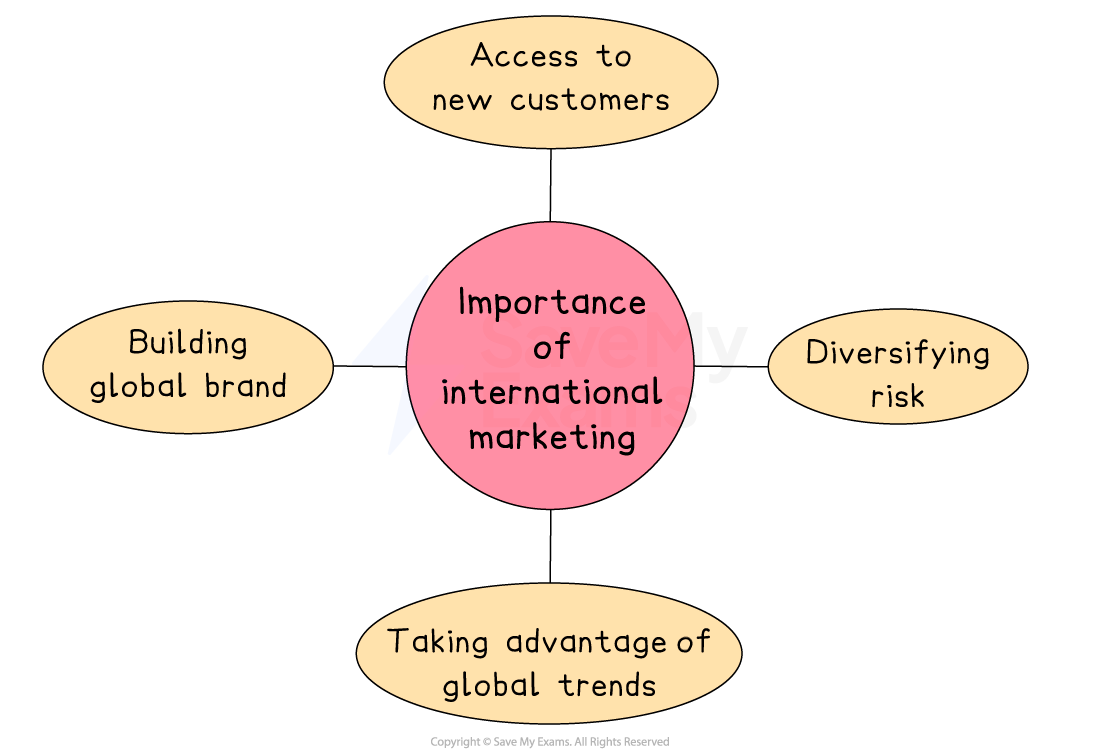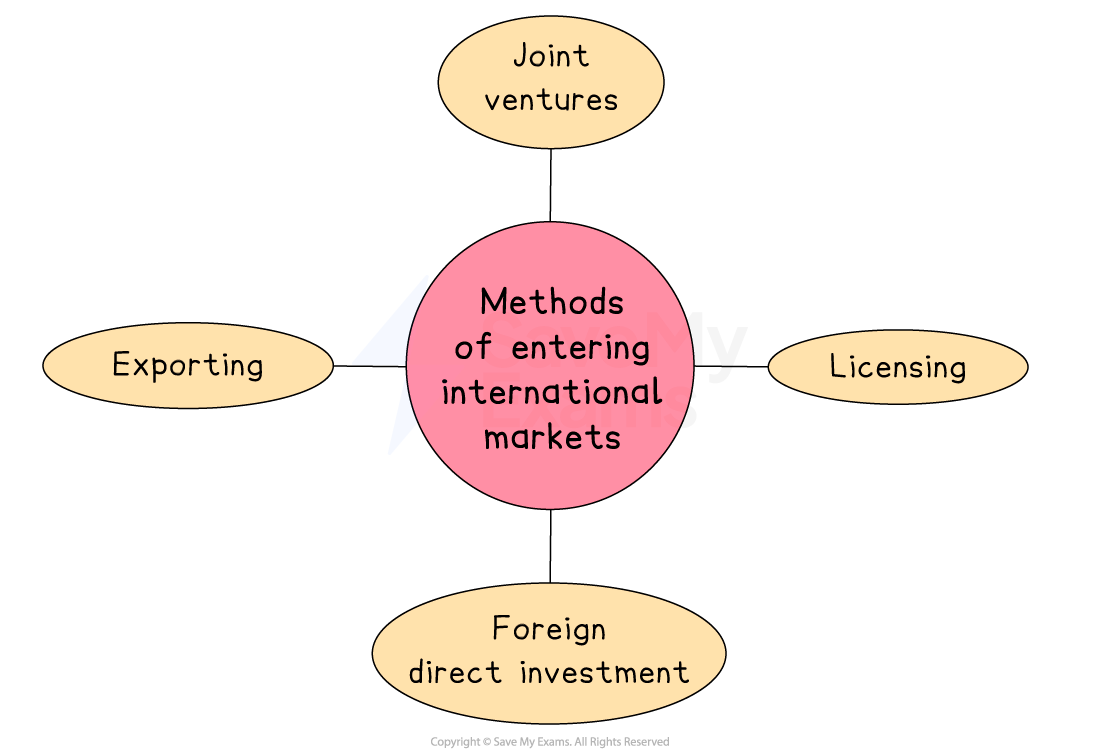Strategies for International Marketing (Cambridge (CIE) A Level Business): Revision Note
Exam code: 9609
Globalisation, economic collaboration and marketing
Globalisation is the increasing connection and interdependence of countries through trade, communication, transport and technology
It allows businesses to operate and compete in international markets more than ever before
Economic collaboration is when countries or regions work together to support trade and economic growth
This includes trade agreements, shared markets, such as the EU, and international organisations, like the World Trade Organisation
Implications for marketing
Implication | Explanation |
|---|---|
Access to larger markets |
|
Increased competition |
|
Need for local adaptation |
|
Joint marketing opportunities |
|
The importance of international marketing
International marketing is when a business promotes and sells its products in more than one country
It plays a key role in helping businesses grow, increase profits and compete globally
Why international marketing is important

Access to new customers
By marketing products in other countries, businesses can reach millions of new potential customers
E.g. Netflix expanded from the US to over 190 countries, gaining millions of new subscribers through localised marketing and content
Spreading risk
Selling in different countries helps reduce risk
If sales fall in one country, sales in other regions may still grow
E.g. Toyota sells vehicles across Asia, North America and Europe, which helps balance profits even if one region performs poorly
Taking advantage of global trends
International marketing allows businesses to respond quickly to global fashion, technology or lifestyle trends
E.g. Zara uses fast-fashion marketing strategies across global cities to catch and promote trends in real time
Building a global brand
International marketing helps businesses build strong global brands that are recognised and trusted around the world
E.g. Samsung has become one of the world’s leading technology brands by using consistent marketing messages and high-quality advertising across Asia, Europe, and the Americas
Identifying and selecting suitable international markets
Before entering a new country, a business must carefully research and choose the right market
Picking the wrong market can lead to wasted investment, while choosing wisely can bring growth and long-term success
Key factors in choosing an international market
Factor | Explanation | Example |
|---|---|---|
Market size and growth |
|
|
Customer needs and preferences |
|
|
Level of competition |
|
|
Legal and political environment |
|
|
Costs and infrastructure |
|
|
Case Study
GreenSip Ltd makes stylish, eco-friendly water bottles aimed at environmentally conscious consumers

The business already sells successfully across the UK and now wants to grow by entering a new international market, either in Brazil or in Sweden
Market comparison of Brazil and Sweden
Factor | Brazil | Sweden |
|---|---|---|
Market size and growth |
|
|
Customer preferences |
|
|
Competition |
|
|
Challenges and ease of entry |
|
|
GreenSip Ltd. chose to enter Sweden as its first international expansion market
Although Brazil offered more long-term growth potential, the management team decided that Sweden was a safer first step
The strong match between Swedish consumer values and GreenSip’s eco-friendly brand made it easier to launch with minimal changes to product design or marketing
Additionally, as part of the EU, Sweden allowed for lower costs, faster delivery and fewer legal barriers
Entering international markets
When expanding into a new country, businesses must decide how to enter and how to market their products
Strategies for entering international markets
Pan-global strategy
A pan-global strategy is where a business uses the same product and marketing approach in all countries
Branding, packaging and promotion stay the same
This approach is best used when customer preferences are similar worldwide, such as in technology or fashion where global trends dominate
Advantages
Saves money through economies of scale
Using the same adverts, packaging and branding worldwide reduces costs
Strong, consistent global brand image
Customers recognise and trust the brand across all markets
Disadvantages
May not suit local tastes or culture
What appeals in one country may not work in another
Risk of marketing failure
The message might not connect with customers in certain regions
Local strategy
A local strategy is where a business changes parts of its product or marketing to suit local tastes, culture, language or laws
This approach is best used when markets are culturally, legally or economically different, such as in food, healthcare or personal care industries
Advantages
Matches local customer needs better
Products and marketing can reflect local tastes, language and culture
More likely to connect with target market
Customers feel the business understands them, which can increase loyalty
Disadvantages
Higher costs due to adaptation
Creating different versions of adverts, packaging or products for each country can be expensive
More complex to manage
Coordinating different strategies across markets requires more time, staff and control
Strategies to develop a global market
When expanding globally, businesses must choose strategies that match their goals, resources, and the markets they are entering
Key factors businesses consider include
Target market analysis
Businesses study customer needs, cultural values, income levels and demand
Helps decide whether to use a pan-global or localised marketing approach
Product type
Some products (e.g. technology, luxury goods) may work globally with little change
Others (e.g. food, personal care) often need local adaptation to suit customer preferences or laws
Resources and budget
Larger businesses may invest in FDI or joint ventures
Smaller firms may start with exporting or licensing due to lower risk and cost
Level of risk
Political stability, economic conditions and ease of doing business affect strategy choice
Higher-risk markets may be entered through partnerships with local businesses rather than full ownership
Competitive environment
Businesses assess the strength and number of competitors
In highly competitive markets, differentiation and strong branding are essential
Case Study
Global expansion strategy – Eco Brew Ltd
Eco Brew Ltd is a Ireland-based business that sells organic, fair-trade coffee in eco-friendly packaging

After strong growth in the domestic market, the company is now looking to expand internationally
The management team must decide which strategy to use to successfully enter and compete in a global market
Step 1: Target market research
Eco Brew’s research team investigated several countries and narrowed the options to Canada and South Korea
Both had strong coffee cultures, but preferences and market conditions differed
Canada had a high demand for ethical, organic products and a shared language and culture with Ireland
South Korea had a fast-growing premium coffee market, but stronger local competition and cultural differences
Eco Brew chose Canada as its first global market due to easier cultural fit, high sustainability awareness and lower risk
Step 2: Choosing a marketing strategy
Eco Brew considered whether to use a pan-global strategy or a local adaptation strategy
Since Canadian consumers value eco-packaging and fair trade, just like Irish customers, Eco Brew decided to keep its branding and product consistent
Only minor adaptations were made, such as using bilingual (English/French) labelling and adjusting promotions to local festivals
Step 3: Selecting a market entry method
Eco Brew considered four main entry options: exporting, licensing, joint venture, and foreign direct investment (FDI)
As a small but growing business, Eco Brew had limited capital
It chose exporting with a trusted Canadian distributor to test the market while keeping risk and cost low.
Methods of entry into international markets
When a business wants to expand into another country, it must decide how to enter that market
The method chosen can affect the level of risk, cost, control and speed of entry
Some businesses may prefer low-risk options like exporting, while others may invest heavily to set up operations abroad
The best choice depends on the business’s goals, resources and the nature of the market it’s entering

1. Exporting
The product is made in the home country and sold overseas, either directly or through agents or distributors
2. Licensing
A local business is allowed to produce and sell the product under the brand name
3. Joint ventures
The business works with a local partner to enter the market, sharing risks, costs and local knowledge
4. Foreign direct investment (FDI)
The business sets up its own operations in the new country by opening a factory, store, distribution facilities or offices
Evaluating each method
Approach | Advantage | Disadvantage |
|---|---|---|
Exporting |
|
|
Licensing |
|
|
Joint ventures |
|
|
Foreign direct investment (FDI) |
|
|

Unlock more, it's free!
Did this page help you?